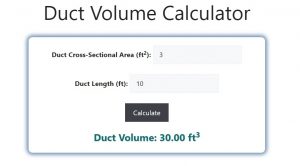About Duct Volume Calculator (Formula)
The Duct Volume Calculator helps you determine the volume of air ducts, which is essential for proper HVAC system design. Knowing the duct volume is crucial for calculating air flow, heating, and cooling capacities in residential, commercial, and industrial settings. Accurate volume calculations ensure the efficient performance of air conditioning and ventilation systems, optimizing air distribution throughout a building.
Formula
The formula for calculating duct volume is:
Duct Volume = Cross-Sectional Area × Duct Length
- Cross-Sectional Area refers to the internal area of the duct’s opening (usually in square feet or square meters).
- Duct Length is the total length of the duct, typically measured in feet or meters.
How to Use
- Determine the Cross-Sectional Area: Measure or calculate the cross-sectional area of the duct. This can be done using the formula for the shape of the duct (e.g., for rectangular ducts: width × height).
- Measure the Duct Length: Measure the length of the duct from end to end.
- Input the Values: Multiply the cross-sectional area by the duct length to find the total volume of the duct.
Example
If you have a rectangular duct with a width of 2 feet, a height of 1.5 feet, and a length of 10 feet:
- Cross-Sectional Area = 2 ft × 1.5 ft = 3 ft²
- Duct Length = 10 ft
- Duct Volume = 3 ft² × 10 ft = 30 cubic feet
So, the volume of the duct is 30 cubic feet.

FAQs
- What is a Duct Volume Calculator?
A Duct Volume Calculator is a tool used to determine the volume of air ducts in HVAC systems to optimize airflow and efficiency. - Why is duct volume important in HVAC systems?
The volume of the duct affects airflow, air distribution, and the efficiency of heating and cooling systems, making it crucial for system design and installation. - How do you calculate the cross-sectional area of a circular duct?
For a circular duct, use the formula: Area = π × (radius²). The radius is half the diameter of the duct. - Can I use this calculator for both round and rectangular ducts?
Yes, you can use this calculator for both round and rectangular ducts by adjusting the cross-sectional area calculation based on the duct shape. - What units should I use for duct volume?
Duct volume is typically measured in cubic feet (ft³) or cubic meters (m³), depending on the units used for the duct’s dimensions. - Is this calculator applicable for flexible ducts?
Yes, the calculator can be used for flexible ducts, but make sure to account for any compression or expansion in the length. - What is the typical length of HVAC ducts?
Duct lengths vary depending on the system design, but common residential duct lengths range from a few feet to over 20 feet. - Can this calculator help in determining airflow requirements?
Yes, calculating the duct volume is the first step in determining airflow, which is crucial for sizing HVAC equipment. - How accurate does the measurement need to be?
For HVAC design, precise measurements are essential to ensure optimal system performance and avoid inefficiencies. - Can this calculator be used for exhaust systems?
Yes, the duct volume calculator is useful for exhaust systems, ensuring proper ventilation and air circulation. - What is the difference between duct volume and duct capacity?
Duct volume refers to the physical space inside the duct, while duct capacity typically refers to the amount of air (in cubic feet per minute, or CFM) that can flow through the duct. - Does duct volume affect air velocity?
Yes, the volume of the duct, along with other factors, influences air velocity and the overall efficiency of the HVAC system. - What are the consequences of using ducts with incorrect volumes?
If ducts are too small, airflow will be restricted, leading to inefficient heating or cooling. If ducts are too large, the system may be overpowered, wasting energy. - Can this calculator be used in industrial applications?
Yes, this calculator is widely applicable in industrial HVAC systems to ensure proper air distribution and ventilation. - How do I calculate duct volume for irregular shapes?
For irregular shapes, divide the duct into simpler shapes (like rectangles or circles), calculate their volumes individually, and then add them together. - What is the standard size for residential HVAC ducts?
Residential HVAC duct sizes vary, but they typically range from 4 inches to 18 inches in diameter for round ducts and from 6×8 inches to 14×20 inches for rectangular ducts. - Does duct material affect volume calculations?
No, duct material does not affect the volume calculation, but it may affect airflow and heat loss within the system. - How does temperature affect duct volume?
Temperature does not change the physical volume of the duct but can influence the expansion or contraction of air within the duct. - Can I calculate duct volume for ventilation systems?
Yes, calculating the duct volume is important for proper ventilation design to ensure the right amount of air is moved through the system. - How do I convert cubic feet to cubic meters?
To convert cubic feet to cubic meters, multiply by 0.0283. For example, 30 cubic feet = 30 × 0.0283 = 0.849 cubic meters.
Conclusion
The Duct Volume Calculator is an essential tool for HVAC professionals and engineers, helping to ensure that air ducts are correctly sized for optimal airflow and system efficiency. Whether you’re working with round or rectangular ducts, calculating the volume allows for better design and functionality in heating, cooling, and ventilation systems. By using this simple calculation, you can avoid costly inefficiencies and ensure a well-balanced air distribution throughout any space.